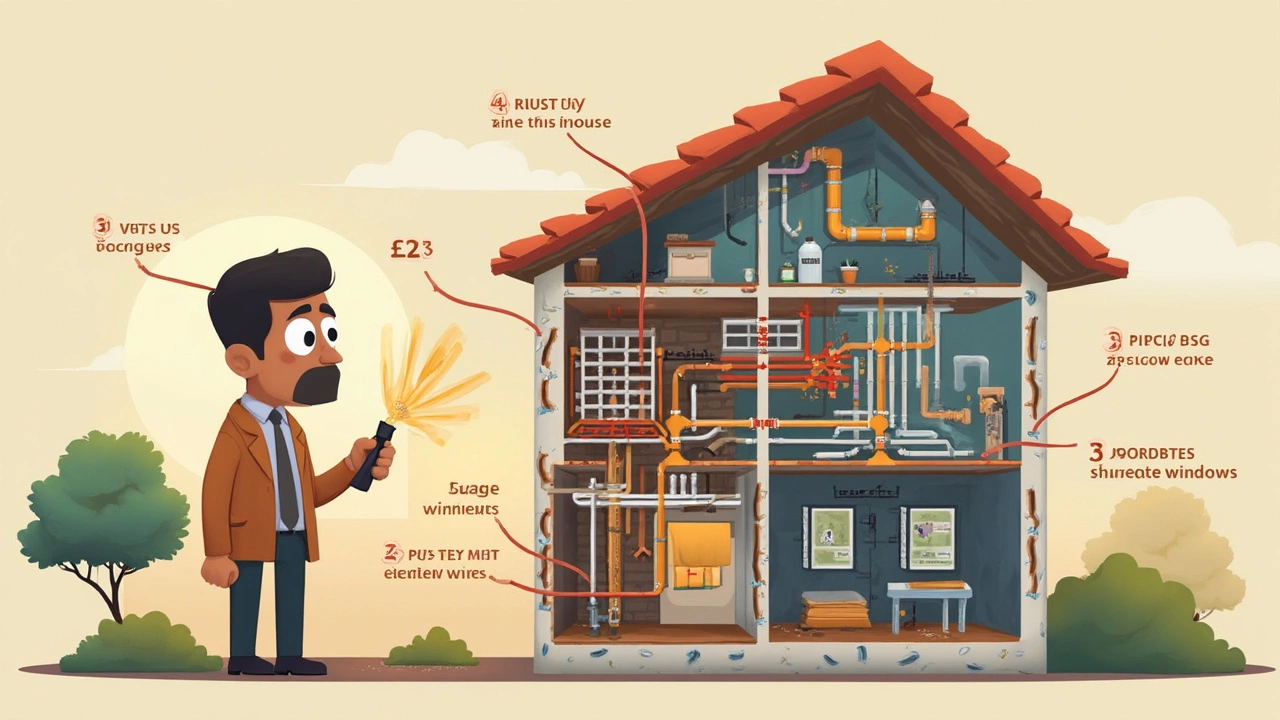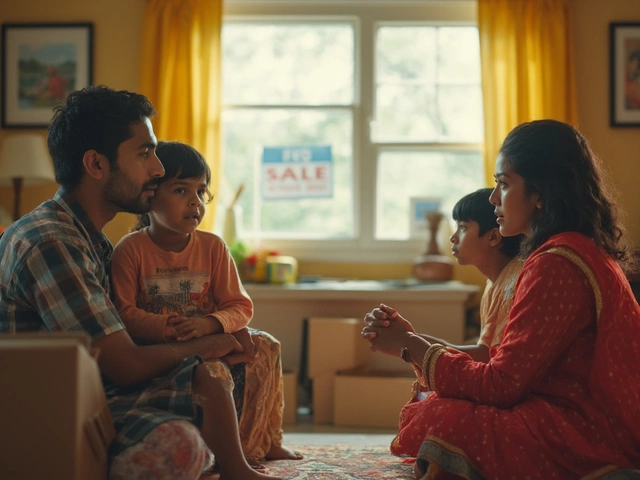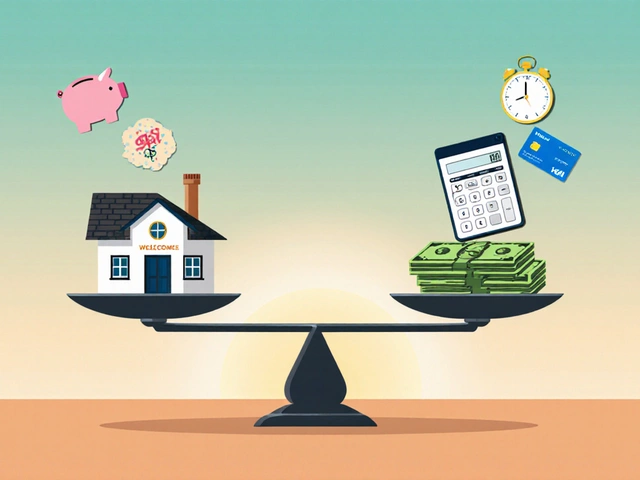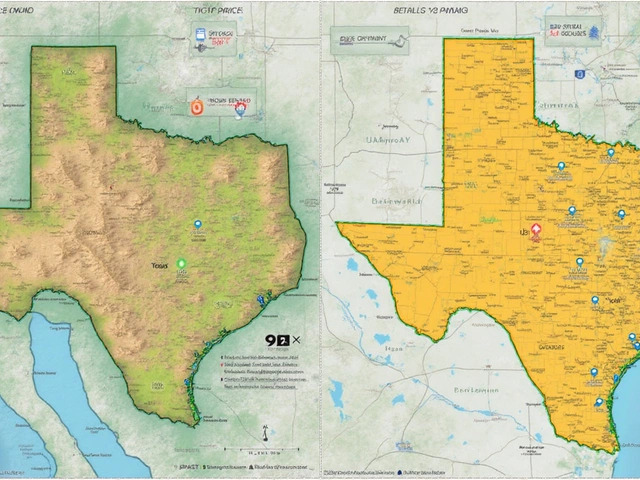Type '30-year-old house' into any online property listing and you'll probably scroll past, thinking it's way past its prime. Here’s the thing—most homes from the mid-'90s still have plenty of life left as long as no one took shortcuts on repairs or ignored problems. The real worry isn’t age, but what’s been done (or not done) in those 30 years.
The crucial details hide behind the photos you see online: the roof’s last replacement, the shape of the plumbing, and what kind of electrical panel is humming behind the walls. A 30-year-old house might still use original pipes, and unless they’re copper or PEX, you could be facing leaks sooner than you think. It pays to know what to look for. Don't just check if the kitchen looks modern—ask about the foundation, insulation, and HVAC system. Small issues at this age can snowball into big repairs, so you want to go in eyes wide open.
- How Old Is 'Too Old' for a House?
- What Really Happens as a House Ages
- Must-Check Areas Before You Buy
- Renovation Costs and Realistic Budgets
- Spotting a Well-Maintained Older Home
- Tips for Buying a 30-Year-Old House Online
How Old Is 'Too Old' for a House?
Scrolling through listings, you might spot a '30-year-old house' label and wonder if you're setting yourself up for headaches. Thing is, there's no magic age where every house turns into a pumpkin. Some houses built 50 or even 100 years ago are still going strong, while others from just 20 years ago are loaded with issues. What matters more than the number is how the house was built and maintained.
The key parts—like roof, pipes, wiring, and foundation—each have their own life spans:
| Component | Expected Lifespan (Years) |
|---|---|
| Asphalt Shingle Roof | 20-30 |
| Clay/Concrete Tile Roof | 50+ |
| Copper Plumbing | 50+ |
| PVC/PEX Plumbing | 40 |
| Furnace | 15-20 |
| Central A/C | 10-15 |
| Electrical Wiring | 70+ |
A 30 year old house usually sits at a tipping point: some stuff may still be fine, but a lot is right around the age where updates pop up. For example, the roof or HVAC system might be due for replacement soon, especially if the house never got big upgrades.
So is 30 really "too old"? Not by a long shot. What makes or breaks a house at this age is maintenance history. If the owners swapped out the roof, patched up any water leaks, and upgraded old wiring, you could be getting a steal. If corners got cut, though, you could end up paying extra down the line. That's why peeking behind the scenes—via records and thorough inspections—is non-negotiable.
Bottom line: Houses don't have an expiry date, but their parts kind of do. Focus on condition over age, and you'll avoid most nasty surprises.
What Really Happens as a House Ages
It’s tempting to think every house just sits still after being built, but time quietly does its thing. Even the best-built homes see parts wear down, shift, and need attention. It’s not just dust and creaky doors—you get changes you can’t even spot in a quick walk-through.
The big hitters are usually the roof, plumbing, electrical systems, and structure (like the foundation or support beams). For example, most asphalt shingle roofs last around 20-25 years, so a 30-year-old house could be on its second roof or about to need a new one. Electrical code also changes every decade, so wiring that was up to standard in 1995 might be behind current safety rules.
"Older homes have charm, but buyers need to check the basics: roof, foundation, plumbing, and electrical. Don't get distracted by pretty kitchens." — Mike Holmes, professional builder (Holmes on Homes)
Let’s talk stats. The National Association of Home Builders put together average lifespans for common home features. Here’s what that might look like for a 30-year-old property:
| Component | Average Lifespan (Years) |
|---|---|
| Asphalt Roof | 20–25 |
| Water Heater | 8–12 |
| Furnace | 15–20 |
| Plumbing Pipes (Copper) | 50+ |
| Electrical Wiring | 50+ |
| Windows | 15–30 |
If updates haven’t happened, stuff like the water heater and furnace is probably near the end of its road, and windows could be drafty or not open right. Watch out for early plastic piping (like polybutylene), which has a reputation for leaking and may need replacing.
One sneaky issue? Settling. Foundations can shift a little over time, especially in places with a lot of rain or clay soil. You don’t always see a crack until it’s a headache. Around year 30, small movements can finally show up as doors sticking or hairline splits in drywall. None of this dooms an older house, but it all means you need to ask questions and maybe budget for some extra fixes.
Must-Check Areas Before You Buy
If you're thinking about buying a 30 year old house—especially if you're doing it online—you really have to dig into the details before hitting that offer button. Some problems hide where the phone camera won’t show, and fixing them costs more than a paint job ever will. Here are the biggies to look out for:
- Roof Age and Condition: Roofs usually last 20–30 years. If the house still has its original shingles, budget for a replacement soon. Ask for receipts or inspection docs—missing, curling, or mossy shingles can mean it’s nearly time for a new one.
- Plumbing: Not all pipes are created equal. Many homes from the '90s have copper (good) but some have polybutylene (bad news—prone to leaks). Check the listing or ask for the seller’s disclosure. Watch for low water pressure or water stains on ceilings, those are red flags.
- Electrical System: Outdated wiring can be a fire risk. Aluminum wiring, for example, isn’t up to today’s safety codes. Ask if the panel’s original or upgraded. If the home still uses old push-button breakers or has a Federal Pacific panel, you’ll want an electrician’s opinion fast.
- Foundation and Structure: Look for cracks along walls or uneven doors and floors—these hint at shifting and costly foundation problems. Foundation repairs can run from a few thousand bucks to tens of thousands, so don’t skip this check.
- Heating and Cooling Systems: Furnaces and air-conditioners typically last 15–25 years. An old, noisy, or grumpy HVAC means a big bill coming—modern units also cut power bills.
- Windows and Insulation: Original single-pane windows aren’t energy efficient. Drafts and high energy bills could be a problem. Good insulation keeps you comfortable and saves money long term.
Here’s a quick look at how long typical house parts last, and how much replacing them sets you back:
| Item | Typical Lifespan | Average Replacement Cost (USD) |
|---|---|---|
| Roof | 20–30 years | $8,000–$15,000 |
| Water Heater | 10–15 years | $1,200–$2,500 |
| HVAC System | 15–25 years | $5,000–$12,000 |
| Windows | 20–30 years | $10,000–$20,000 (whole house) |
| Plumbing | 40–70 years (copper) | $5,000–$15,000 (full repipe) |
Try to get inspection photos or reports in advance. If something looks off, don’t get shy about hiring your own inspector—even if you’re buying from afar. A few hundred bucks upfront can save you from a nasty surprise or the world’s most expensive roof leak. Got questions? Ask the seller—get documents and dates for every big system. That way, you know exactly what you’re getting into before you sign any paperwork.

Renovation Costs and Realistic Budgets
Buying a 30 year old house means you’re almost guaranteed to spend something on fixes, but how much are we talking? The most common big-ticket items are the roof, windows, HVAC, electrical, and plumbing. Roofs last 20 to 30 years, so if no one’s replaced it yet, plan for $8,000 to $14,000, depending on size and shingles. Windows can run $400 to $700 each, installed. Heating and cooling systems, if original, could be overdue for a $6,000 to $9,000 upgrade. For electric panels, swapping out old ones (especially if they’re not up to modern code) can cost between $2,000 and $4,500.
Old plumbing can be sneaky expensive, especially if the house has galvanized or polybutylene pipes. Budget at least $4,000 to $10,000 for a whole-house repipe, depending on where you live. Cosmetic stuff—paint, floors, bathrooms, kitchens—ranges, but a typical kitchen remodel lands around $20,000 to $40,000 if you want fresh cabinets and appliances.
If you want to avoid that scary money pit feeling, make a renovation plan before buying. Here’s a quick way to build a realistic budget:
- Get a professional inspection first—this helps uncover what’s essential vs. cosmetic.
- Tally up urgent repairs and code-required upgrades.
- Set aside 10-20% more as a buffer, because old houses usually hide surprises.
- Think about what you can DIY and what needs a pro, since labor is most of the cost.
- Get detailed quotes for everything, even if you have to research local contractor averages.
If you add up these numbers and the total still beats the price of a newer, move-in ready place, you’re probably getting a good deal. Just keep in mind that some upgrades, like new HVAC or energy-efficient windows, actually lower your utility bills over time, so factor that in when making your decision.
Spotting a Well-Maintained Older Home
You can usually tell right away when a 30 year old house has had the right kind of care. The big stuff comes first—look for a roof with no sagging, missing shingles, or weird patches. A lot of roofs only last 20-25 years, so if nobody’s replaced it yet, you’ll want to budget for that pretty soon.
Next up: check the foundation. Small, hairline cracks are normal in older homes, but splits wider than a pencil are red flags. Walk around inside and outside. Doors and windows that stick often signal settling problems. Foundation repairs aren’t cheap, so you want things to be stable.
Now, tour the heart of the home—the systems that keep it running. A well-kept 30 year old house should have updated electrical panels, grounded outlets, and GFCI protection (especially in kitchens and bathrooms). If you still see old, round light switches or a breaker box covered in tangled wires, expect extra electrician costs.
- Plumbing: Turn on taps and check under sinks for leaks. Listen for knocking or weird water pressure. Pipes from the '90s could be copper (great), PEX (also solid), or Polybutylene (trouble—those have a history of failing).
- Heating/Cooling: Furnaces and air conditioners usually last 15 to 20 years if serviced. Ask for proof of regular maintenance. A unit older than 20 years is on borrowed time.
- Insulation & Windows: Good insulation keeps energy bills down. Double-pane windows are a sign the house was upgraded. If the windows are original and hard to open, get ready for drafts.
Another clue: the smell. If you walk in and it smells musty or like mildew, there’s probably water damage or a history of leaks. Hidden mold costs a fortune to fix. Trust your nose here.
Finally, look at the small stuff. Fresh paint isn’t always just for looks—sometimes it hides problems. Check for uneven walls, weird dips in the floors, or spots that seem strangely new. Ask for receipts on repairs and upgrades; it shows real pride of ownership. Well-documented fixes are a huge plus when buying online, where you can’t always see everything in person.
Tips for Buying a 30-Year-Old House Online
Shopping for an older home online is a whole different game compared to looking at new builds. You can’t just trust the pretty pictures or polished listing descriptions. Here’s how to actually spot the winners—and avoid money pits—when you’re considering a 30 year old house for sale across the web.
- Get an Inspection—No Excuses: Don’t even think about skipping this step. A full inspection is non-negotiable. Older homes might look fine in photos, but big-ticket problems (like old wiring or foundation cracks) aren't always visible.
- Request Maintenance Records: Ask for documents showing roof replacements, furnace age, pest treatments, and any remodel permits. If the seller can’t provide this, that’s a major red flag.
- Review a Seller’s Disclosure: This document lists any known issues, repairs, or remodels. Some states require these, but others don’t—so double-check what’s legally needed in your area.
- Investigate Major Systems: Plumbing, electrical, and HVAC systems are the expensive bits in older houses. Ask for the age and service history of these—many roofs only last 20 to 30 years, so a 30-year-old roof could mean a replacement is due.
- Check Insurance Costs: Older homes sometimes cost more to insure, especially if there’s outdated electrical or roof issues. Get a quote before you buy so you know what you’re getting into.
- Zoom in on Photos: Look beyond the fresh paint. Use the zoom to check for water stains on ceilings, cracks in exterior brick, or wavy floors, which can spell foundation trouble.
Here’s a quick table comparing what you might find in a 30-year-old house versus a newer build:
| Feature | 30-Year-Old House | New Build |
|---|---|---|
| Roof Age | May be at or near replacement | Under warranty |
| Plumbing Type | Possibly galvanized steel or older copper | PEX or new copper |
| Electrical | May have outdated panels | Modern codes, GFCI everywhere |
| HVAC | Older units, might need upgrade | New, efficient system |
| Energy Efficiency | Mixed—sometimes poor insulation | Usually insulated to current standards |
Don’t be afraid to ask the seller for a live video walkthrough. This way, you can see details the camera angles in listings might hide. When Amara and I bought our last house online, the video chat helped us notice drafty windows and a cracked patio the photos completely missed.
Lastly, always double-check the neighborhood and check for past floods, fires, or weather damage. Plenty of people score fantastic deals with older homes online—just make sure you have the facts before you click 'buy.'





